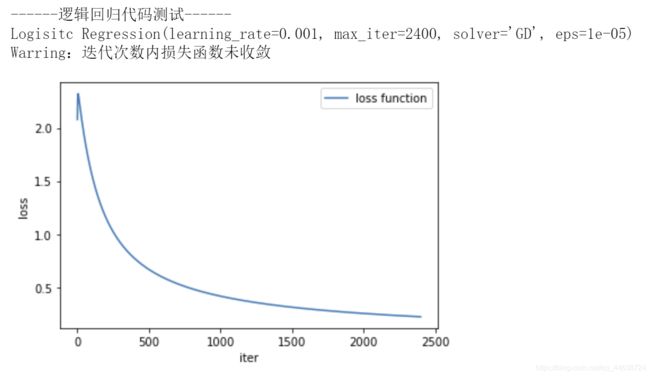逻辑回归中的梯度下降
这次使用了类的编程方法, 集成度、效率更高, 代码量更少, 使用更少的库
import numpy as np
import matplotlib.pyplot as plt
class LogisticRegression:
def __init__(self,
learning_rate=0.001,
max_iter=100,
solver=None,
error=1e-5): #设定模型参数
print("------逻辑回归代码测试------")
self.learning_rate = learning_rate
self.max_iter = max_iter
self.error = error
solver_list = ['GD', 'newton-cg', 'lbfgs', 'sag', 'saga'] #其它求解方法后续会加入
if solver == "GD" or solver == None:
self.solver = "GD"
print(
"Logisitc Regression(learning_rate={0}, max_iter={1}, solver='{2}', eps={3})"
.format(learning_rate, max_iter, solver, error))
else:
print(
"Logistic Regression supports only solvers in ['GD', 'newton-cg', 'lbfgs', 'sag', 'saga'], got {0}"
.format(solver))
def pdf(self, x, mu, gamma, plot): #绘制概率密度函数
f = np.exp((mu - x) / gamma) / (gamma * (np.exp(
(mu - x) / gamma) + 1)**2)
if plot == True:
plt.ylabel(f'$F(x)$')
plt.xlabel(f"$x$")
plt.vlines(mu, 0, max(f), linestyles="dashed")
plt.title("PDF")
plt.plot(x, f)
plt.show()
def cdf(self, x, mu, gamma, plot): #绘制累计分布函数
F = 1 / (1 + np.exp(-(x - mu) / gamma))
if plot == True:
plt.ylabel(f'$F(x)$')
plt.xlabel(f"$x$")
plt.vlines(0, 0, 1, linestyles="dashed")
plt.title("CDF")
plt.plot(x, F)
plt.show()
def fit(self, X, Y, beta=None, plot=None): #训练模型
x = np.array(X)
y = np.array(Y)
beta = np.zeros(x.shape[1])
self.coef_ = beta
n = len(y)
Loss = [0]
if self.solver == "GD": #梯度下降法
for i in range(self.max_iter):
phi = 1 / (1 + np.exp(-np.dot(self.coef_, x.T)))
self.coef_ = self.coef_ + self.learning_rate * np.dot(
(y.T - phi), x) / n
Loss.append(-np.dot(y, np.log(phi).T))
loss = abs(Loss[-1] - Loss[-2])
if loss <= self.error:
break
elif len(Loss) == self.max_iter and loss > self.error:
print('Warring:迭代次数内损失函数未收敛')
if plot == True:
plt.xlabel("iter")
plt.ylabel("loss")
plt.plot(Loss[1:-1])
plt.legend(["loss function"])
plt.show()
if self.solver == "newton-cg": #拟牛顿法
print("拟牛顿法")
if self.solver == "lbfgs":
print("lbfgs")
def predict_pro(self, testX): #对新输入进行预测
neg = 1 / (1 + np.exp(np.dot(self.coef_, testX.T)))[0]
pos = 1 - neg
return np.array([neg, pos])
用法
- 创建回归对象
LR = LogisticRegression(learning_rate=0.001, max_iter=2400, solver='GD')
- 给定输入输出
X = [[1, 20, 3], [1, 23, 7], [1, 31, 10], [1, 42, 13], [1, 50, 7], [1, 60, 5]]
Y = [0, 1, 1, 1, 0, 0]
- 训练模型
LR.fit(X,Y,plot=True) #可以用plot参数来控制是否绘制损失函数的收敛过程
LR.coef_
>>> array([-0.0015688 , -0.19926538, 0.91831361])
- 对新输入进行预测
testX=np.array([[1,28,8]])
LR.predict_pro(testX)
>>> array([0.14610166, 0.85389834])
对新输入样本的预测结果为: P ( Y = 0 ∣ X ) = 0.14610166 , P ( Y = 1 ∣ X ) = 1 − P ( Y = 0 ∣ X ) = 0.85389834 P(Y=0|X)=0.14610166,P(Y=1|X)=1-P(Y=0|X)=0.85389834 P(Y=0∣X)=0.14610166,P(Y=1∣X)=1−P(Y=0∣X)=0.85389834
- 同时还可以查看逻辑斯蒂分布
data = np.arange(-30,30,0.01) #设定x
LR.cdf(data,2,4,True)
LR.pdf(data,2,4,True)

